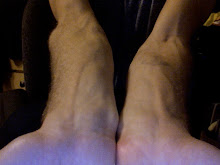Phroq, Collapse [Ground Fault, 2005]
Digital noise ranging from harsh density to quiet sparsity characterizes this album. Computer-generated clicks and chirps, paired with the severely tinny sound of contact mics, dominate the quiet sections. The loud sections are idiomatic harsh noise -- these same sound sources blown-out and obscured by over-loaded reverb and distortion plugins, creating an unrelentingly heavy assault. As these descriptions imply, much of the album is a series of textures - textures which rarely develop within themselves, and which are comprised of sounds that are seldom significant beyond being constituents of the whole. The sequencing and layering of these essentially static textures creates the most significant forms of the pieces.
In this way, "Psychotest, Last Attempt" (#6) sensitively collages digital clicks and rumbles with matching field recordings of rain, insects, birds, and dirt bikes. The piece starts digitally, slowly layers various field recordings on top, then holds steady while at least one 70-second field recording loops about 3 times. It returns to digital clicks, this time with more rhythmic variety, as an outro.
"The Litigation" (#8) shows the most sophistication in manipulating sound. There is less straight texture in this piece. Individual sounds carry more meaning, and strings of sounds begin to resemble phrases rather than amorphous grains. The contact mic rustling near the beginning is slow enough, and interesting enough, to allow rhythmic significance to emerge. Coming in over the top of that is what sounds like some sort of data file opened in an audio editor -- erratically changing digitally distorted tones and noises. Though chaotic, it too reveals itself in something approaching coherent phrases. And so on. The extra depth in each texture adds immensely to the interest of this piece. The variety of sounds spans the spectrum from harsh noise doused in reverb and characterized by wildly shifting feedback tones, to crackly digital sounds blended with field recordings, reaching an eai-level of minimalism at points.
When Francisco Meirino writes, "The collapse of your expectations and reactions to music leads to noise," perhaps he is referring to the unmusicality of the sequences of textural blocks which make up most of the album, and the even more alien nature of the uncomfortably quiet, single texture "Attempt" pieces. For my part, I prefer the longer pieces in which ideas are able to fully develop and resolve on this macro scale (#6), and especially when they also possess more facundity on the smaller scale as well (#8). Are these pieces not noise for this reason, and is this success or failure for Meirino? And what does it mean that the most overtly "noise" sections of the music are the most expected, the most predictable? Noise, after all, is a fairly established genre. It is perhaps worth noting that Ground Fault categorizes this album as part of "Series II (medium)" rather than "Series III (loud)", which includes the genre "Noise" along with "Extreme", "Harsh", and "Power Electronic". This table of genres, printed on the inside cover of the album, is rather thought-provoking.
Contemplation aside, at it's best, this is some great electronic music with which it is worth engaging.
recommended tracks: 8, 6, 2
In this way, "Psychotest, Last Attempt" (#6) sensitively collages digital clicks and rumbles with matching field recordings of rain, insects, birds, and dirt bikes. The piece starts digitally, slowly layers various field recordings on top, then holds steady while at least one 70-second field recording loops about 3 times. It returns to digital clicks, this time with more rhythmic variety, as an outro.
"The Litigation" (#8) shows the most sophistication in manipulating sound. There is less straight texture in this piece. Individual sounds carry more meaning, and strings of sounds begin to resemble phrases rather than amorphous grains. The contact mic rustling near the beginning is slow enough, and interesting enough, to allow rhythmic significance to emerge. Coming in over the top of that is what sounds like some sort of data file opened in an audio editor -- erratically changing digitally distorted tones and noises. Though chaotic, it too reveals itself in something approaching coherent phrases. And so on. The extra depth in each texture adds immensely to the interest of this piece. The variety of sounds spans the spectrum from harsh noise doused in reverb and characterized by wildly shifting feedback tones, to crackly digital sounds blended with field recordings, reaching an eai-level of minimalism at points.
When Francisco Meirino writes, "The collapse of your expectations and reactions to music leads to noise," perhaps he is referring to the unmusicality of the sequences of textural blocks which make up most of the album, and the even more alien nature of the uncomfortably quiet, single texture "Attempt" pieces. For my part, I prefer the longer pieces in which ideas are able to fully develop and resolve on this macro scale (#6), and especially when they also possess more facundity on the smaller scale as well (#8). Are these pieces not noise for this reason, and is this success or failure for Meirino? And what does it mean that the most overtly "noise" sections of the music are the most expected, the most predictable? Noise, after all, is a fairly established genre. It is perhaps worth noting that Ground Fault categorizes this album as part of "Series II (medium)" rather than "Series III (loud)", which includes the genre "Noise" along with "Extreme", "Harsh", and "Power Electronic". This table of genres, printed on the inside cover of the album, is rather thought-provoking.
Contemplation aside, at it's best, this is some great electronic music with which it is worth engaging.
recommended tracks: 8, 6, 2
Labels: fixed media reviews


0 Comments:
Post a Comment
<< Home